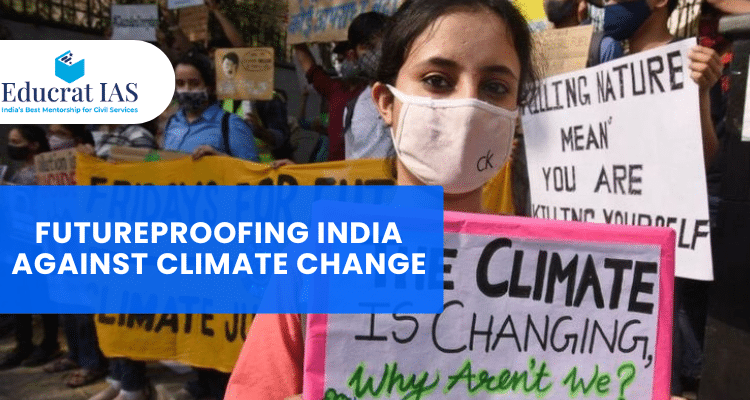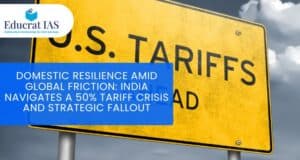Imagine waking up to smog-thick air, dry taps, and a flood warning — all in the same week.
That’s not a distant future; it’s the new reality of climate-stressed India.
Over the past two decades, India has lost more than $79.5 billion to climate disasters. From heatwaves scorching Delhi to coastal flooding in Chennai and crop losses in Maharashtra, climate change is quietly reshaping India’s geography, economy, and society.
For UPSC aspirants, understanding this transformation isn’t just about current affairs — it’s about connecting the dots between environment, economy, governance, and social resilience. The question now is:
Can India turn its climate challenge into an opportunity for sustainable growth — or will inaction cost us our future?
India’s Growing Climate Threats
1. Heatwaves and Floods – A Deadly Double Whammy
Northern, Central, and Western India now face extreme heat and intense rainfall simultaneously. By 2030, over 80% of Indian districts could be climate-vulnerable, threatening infrastructure, crops, and livelihoods.
2. Sea-Level Rise and Coastal Flooding
Rising seas are inching closer to Mumbai, Kochi, and Chennai. The Sundarbans could lose up to 80% of their mangrove cover by 2100, endangering both biodiversity and millions of coastal residents.
3. Water Scarcity Deepens
India’s per capita freshwater availability has dropped by 73% since 1950. With aquifers depleting and rainfall becoming unreliable, India is entering a water crisis era that could disrupt agriculture and urban life.
4. Health on the Edge
Between 2000 and 2021, heat-related deaths rose by 55%, while malaria and dengue outbreaks surged due to warmer temperatures. Climate change is not just an environmental issue — it’s a public health emergency.
5. Energy Security Challenges
Extreme weather reduces hydropower reliability while increasing electricity demand for cooling. India’s 70% dependence on coal continues to challenge its renewable transition goals.
6. Agriculture Under Stress
By 2050, India may see yield declines of:
- Rainfed rice – 20%
- Wheat – 19.3%
- Kharif maize – 18–23%
This poses grave risks to food security and rural livelihoods — two pillars of India’s socio-economic stability.
7. Economic Fallout
Climate change could shrink India’s GDP by 3–10% annually by 2100, disrupting industries, trade, and employment.
Why India’s Climate Policies Fall Short
Weak Enforcement and Regulatory Gaps
Fragmented governance and diluted policies — like the 2023 Forest Conservation Act amendment — weaken India’s ability to enforce environmental safeguards.
Growth vs. Sustainability Conflict
Mega-projects such as the Great Nicobar Island development expose how economic expansion often trumps ecological balance.
Greenwashing Risks
Schemes like the Green Credit Policy risk creating illusory progress — reporting plantations in non-forest areas as “forest cover.”
Urban Climate Vulnerability
Six of the world’s ten most polluted cities are in India, exposing the weakness of current urban resilience frameworks.
Underinvestment in Adaptation
While mitigation efforts grab attention, adaptation funding remains insufficient. The National Adaptation Fund for Climate Change (NAFCC) has been downgraded, signaling reduced institutional priority.
How India Can Build Climate Resilience
1. Localized Climate Risk Mapping
Harness AI, GIS, and micro-zonation to design district-level adaptation plans. Localized data ensures smarter, faster responses.
2. Climate-Responsive Urban Design
Adopt blue-green infrastructure, reflective materials, and modern building codes to manage heat and water stress effectively.
3. Agroecological Transition
Encourage millet-based and climate-smart agriculture, especially in drought-prone areas, to ensure sustainability and nutrition security.
4. Resilient Infrastructure Audits
Make climate-resilience audits mandatory for all major infrastructure projects — from highways to power grids.
5. Decentralized Renewable Energy
Develop hybrid solar-wind-bio systems in rural regions to ensure clean, reliable energy for vulnerable communities.
6. Early Warning Systems
Integrate real-time satellite monitoring and local knowledge systems to improve alerts for floods, cyclones, and glacial outbursts.
7. Integrated Coastal Protection
Build coastal buffer zones combining mangrove restoration, bioshields, and sustainable housing models.
8. Green-Skill Development
Launch a Green Resilience Skilling Mission to create climate-focused employment opportunities for India’s youth.
9. Community-Led Water Governance
Empower village-level water user groups to manage aquifers and recharge systems — promoting local accountability.
10. Climate Finance Mobilization
Scale up green bonds, climate insurance, and private partnerships to fund adaptation and innovation.
11. Promoting Climate Literacy
Integrate climate education into schools, governance, and community outreach — making sustainability a shared responsibility.
Analytical Insights for UPSC Mains
- From Reactive to Anticipatory:
India must move from disaster response to disaster prevention through foresight and planning. - Mainstreaming Resilience:
Climate resilience must become part of national and state-level development planning to align with Panchamrit goals and SDGs 2, 6, 11, 13, 15, and 16. - Community-Driven Models:
Local action remains the cornerstone of effective adaptation — bottom-up governance is key. - Mitigation and Adaptation Must Coexist:
India must prioritize both — reducing emissions and building resilience simultaneously. - Multi-Sectoral Collaboration:
A holistic, inter-ministerial approach linking energy, health, water, and agriculture is the way forward.
India’s climate challenge isn’t a future threat — it’s a present reality unfolding in every monsoon delay, every dry well, every smog-choked morning.
But it also presents an opportunity — to redefine growth, rethink governance, and rebuild resilience. By localizing climate planning, empowering communities, and investing in sustainable infrastructure, India can shift from being climate-vulnerable to climate-ready.
The question for policymakers — and for the next generation of civil servants — is simple yet profound:
Will we continue reacting to disasters, or will we lead the change?
UPSC Insight for Aspirants
Climate resilience is no longer a subtopic — it’s a core governance issue.
For detailed environment and climate analysis tailored for UPSC Mains and Prelims, download the Educrat IAS Current Affairs Magazine — your trusted source for crisp, exam-relevant notes with context, analysis, and government perspectives.





